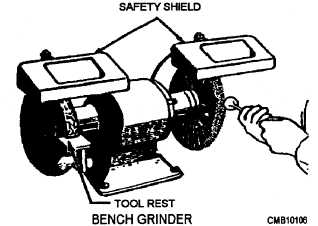
Figure - 3-54.Valve rotators.
clearance between the valve stem and guide. The O ring is a small, round seal that fits into an extra groove cut into the valve stem. It fits on the valve stem after the spring and retainer. Unlike the umbrella type, it seals the gap between the retainer and the valve stem, not the guide and stem. It stops oil from flowing through the retainer down the stem and into the guide.
A valve rotator (fig. 3-54) turns the valve to prevent a carbon buildup and hot spots on the valve face. There are two types of retainersthe release type and the positive type. The release type of rotator releases the spring tension from the valve while open; this allows the valve to rotate from engine vibration The positive rotator is a two-piece valve retainer with a flexible washer between the two pieces. A series of balls between the retainer pieces roll on machined ramps, as pressure is applied and released from the opening and closing of the valve. The movement of the balls up and down the ramps translates into rotations of the valve.
Reconditioning Valves Valve reconditioning includes grinding valves and valve seats, adjusting valve tappet clearances, installing new valve seat inserts, and timing the valves.Together, these operations constitute the VALVE SERVICE necessary for smooth engine performance and maximum power output.
To recondition valves and valve seats, first remove the cylinder head from the engine. Once the cylinder head is off, remove the carbon from the head, the cylinder block, and the pistons. In cleaning the top of the piston, you must exercise care to prevent gouging and scratching, as rough spots collect carbon readily and lead to preignition and detonation during operation. Remove the valves using a valve spring compressor. Next, clean the valves with a wire brush or buffing wheel (fig. 3-55). When the buffing wheel is being used, make sure you wear proper eye protection to prevent wire and other foreign matter from flying into your eyes.
Be careful not to interchange the valves. Bach valve must be replaced in the same valve port from which it was removed. The valve stem moving up and down in the valve guide develops a wear pattern. And, if the valves are interchanged, a new wear pattern is developed. This causes excessive wear on the valve stem and guide.
To eliminate confusion, you should devise a system to identify a valve with the cylinder from which it was taken. The most common way to identify valves is to

Figure 3-55.Cleaning a valve with a wire buffing wheel.
Continue Reading